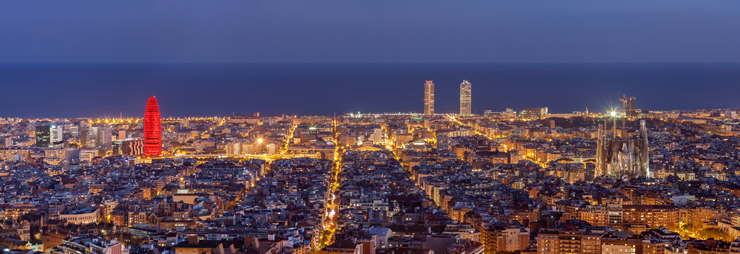Tourist Information

Barcelona
Almost 4.5 million people live in the Barcelona metropolitan area. The city enjoys a prime location, bathed by the sea and has excellent transport links with the rest of Europe. The Mediterranean and Europe are the defining characteristics of the capital of Catalonia.
Barcelona is a modern, cosmopolitan city, but has inherited many centuries of history. Its geographic location and the open character of its inhabitants are the reasons why the city is being culturally enriched all the time. It has a valuable architectural and monumental heritage, the most splendid exponents of which are its Gothic and modernista buildings. Nine of its buildings have been designated World Heritage Sites. The entire city guarantees that visitors will enjoy taking a stroll around its streets which are replete with charm.
Bus, Subway and Taxi
Bus, subway and taxi are commonly used in Barcelona. The complete list of bus lines and information on the stops, the complete list of subway lines and stations, as well as the timetables can be found here. Several companies offer taxi services (with the same fares): Radio taxi or TaxiLand, among others.
Restaurants
Barcelona offers visitors almost any type of cuisine. You can look for you favorite type of restaurant here.
Getting around the city
Public transport is the most practical way of getting around the city. We recommend you use public transport and alternative means of transport such as bicycles in order to get around the city. There is no better way to discover the city than by walking through its streets. If you come to the city by car your best bet is to leave your vehicle in a car park and enjoy your visit by bus, metro or taxi. METRO y FGC: Barcelona currently has six metro lines covering a total of 86.6 kilometres and passing through 123 stations. Barcelona underground (metro): http://www.tmb.net Ferrocarrils de la Generalitat de Catalunya: http://www.fgc.es BUS: Barcelona has a fleet of 1000 buses which operate on over 80 routes and connect all the city's districts. http://www.tmb.net TAXI: Barcelona has a fleet of 11,000 taxis which can be easily identified by their yellow and black livery. More information: http://www.barcelonaturisme.com/Moverse-por-la-ciudad/
Be extremely careful with pickpoteing, specially in the touristic sites, as you might be a perfect target for thieves. Unfortunately, Barcelona is singled out as being particularly dangerous pickpocket havens.
What to visit?
You will always find something to do in Barcelona. The city has over 50 museums, showcasing permanent collections of works by artists such as Picasso, Joan Miró and Antoni Tàpies, although most museums stage temporary exhibitions. Barcelona has museums devoted to art, science, sport, history, archaeology and many other fields. Be sure not to miss some of the most interesting, such as the Museu Picasso, the Museu d'Art Contemporani de Barcelona (MACBA), the Fundació Joan Miró and the Museu Nacional d'Art de Catalunya (MNAC). They outstand not only for its incomparable works of art, but for its spectacular architectures. At the MNAC you can see one of the world's most important collections of Romanesque art. There are famous collections of contemporary art housed in museums such as the MACBA and CaixaForum. If you want to gain a better insight into the history of Barcelona, you can visit the Museu d'Història de la Ciutat located inside the Roman wall. You can also take a look at the many art galleries dotted around the city. The city is also a showcase for the best of the country's theatrical talent. Barcelona is also renowned for its wide variety of musical events, which includes all the genres, and has three major venues: the Gran Teatre del Liceu, devoted to opera, the Palau de la Música, a modernista marvel, and L'Auditori, the concert hall designed by Rafael Moneo. Barcelona is a box of surprises which will keep you entertained with countless cultural and recreational activities. Barcelona is an open-air museum. You can visit it by bus, bicycle or on foot, and enjoy its bustling streets. There are many ways to discover the city and a whole host of things to do, for those interested in culture, for those in search of entertainment or for those thinking about where to do some shopping.
Day itineraries: http://www.barcelonaturisme.com/wv3/en/page/2/day-itineraries.html Themed routes: http://www.barcelonaturisme.com/wv3/en/page/13/themed-routes.html
History
The history of Barcelona extends over 4000 years, from the late Neolithic period, with the first remains found in the territory of the city until today. Her character takes the legacy of Iberian peoples (laietans), Carthaginians, Romans, Jews, Visigoths, Muslims and Christians. It has been suggested by several historians that the barcelonian character was forged based on armed conflicts which almost always have had in common the defence of individual freedom and against absolutism. The war "dels segadors" (1640), the site of 1714, the bombing of Barcelona in 1842 by General Espartero and in 1938 during the Spanish Civil War are examples of this. Voltaire spoke in 1751 of "the extreme love of the barcelonians for freedom".
To learn more about the history of the city we recommend visiting:
- Museu d'Història de Barcelona: www.museuhistoria.bcn.cat/en
- Museu d'Història de Catalunya: www.en.mhcat.cat
- Archivo de la Corona de Aragón: http://en.www.mcu.es/archivos/MC/ACA/
Useful telephone numbers
Emergency Phones
- Unified emergency telephone: 112
- Health Emergencies: 061
- Fire: 080
- Police (city): 092
- Police (national): 088
- Pharmacy: 0034 934 810 060
Transport
- TMB (Bus, Metro): 0034 902 07 50 27
- Ferrocarrils de la Generalitat: 0034 932.051.515
- Renfe: 0034 902.240.202
- Airport (information): 0034 902.404.704
- Taxis: 0034 932.250.000 / 0034 933.033.033
- Taxis for disabled: 0034 934.208.088
-
January 30th 2018
Registration opens -
January 30th 2018
Call for abstracts opens -
April 30th 2018
Deadline for abstract submission -
June 4th 2018
Early registration deadline
